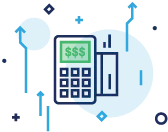TABLE OF CONTENTS
If your business accepts credit card payments, it’s important to understand relevant security measures like CVV codes. Credit card companies include a range of security measures that help prevent fraud. One of the most common security methods is a CVV code on your card. So, you might be wondering: What is CVV? In this guide, we’re going to explore everything you need to know about a CVV number. Whether you’re a customer or a business owner, it’s essential to understand the significance of CVV codes.
What is a CVV Number and What Does CVV Mean?

CVV stands for Card Verification Value. Some card issuers will also refer to it as a card verification code or card verification number.
A CVV number is a number on credit and debit cards that acts as an extra layer of security. As a merchant, it’s vital you ask for both the credit card number as well as the CVV number when purchasing an item. This is to ensure the person making the purchase has access to the physical card.
Where is Your CVV Number?
Unfortunately, not all CVV numbers are in the same location. Where the number is on your card will depend on what type of credit card you have. Let’s explore the various locations below depending on your provider.

CVV on Visa, MasterCard, and Discover cards
If you have a Visa, MasterCard, or Discover card, the CVV will be on the back of the card. If you look on the right side, the signature panel should contain a three-digit number. This code is the number that you will input when asking a customer for a CVV code.

CVV on American Express cards
On the other hand, American Express cards have a CVV code on the credit card’s front. The CVV on the card will be a four-digit number near the top right-hand side.
Many new American Express credit card holders mistakenly use a number from the back of the card. However, most online merchants will not accept this. It’s important you guide your customer to always use the four digits on the front of their American Express card.
What is the Purpose of CVV Numbers?
When fraudsters look for ways to make money off people’s credit card numbers, one of the most common targets is card-not-present transactions. These types of transactions include online payments and phone payments. As these payments cannot be verified in person, card issuers and merchants develop strategies to mitigate potential risks.
A CVV code is one of the most popular strategies. By asking for this code and customers’ credit card number information, you can have confidence that your customer is who they say they are.
In many cases, merchants will also request additional information, such as the billing address. You can cross-reference this data across banking details to ensure that it’s correct. These steps are an effective tool to prevent fraudsters from using stolen credit card data online.
Is There a Difference Between a CVV and a PIN?
The short answer is, yes. A CVV code is typically used to verify online payments or payments when the card is not present. On the other hand, a PIN is used to withdraw cash from ATMs and make payments in-store.
While both numbers are used to verify the authenticity of a transaction, they differ in their use. A merchant will rarely ask for a customer’s CVV in person, whereas, a PIN is regularly utilized for card transactions in a terminal.
How to Protect Your CVV Code
Most people take great care to protect their credit card numbers and PINs, but fewer apply the same efforts to protect their CVV codes. Protecting your verification codes for business cards (or personal) is one of the most important steps in keeping card details safe. Let’s explore some tips for keeping your credit card details safe.

Keep your CVV number safe

As your verification code is the last line of defense against potential fraudsters, it’s essential to keep it away from prying eyes. Let’s explore some common tips to avoid CVV exposure:
- Don’t Save Your CVV on Unsecure Platforms. Don’t make the mistake of storing business credit card details on shared computers or other platforms that are unsecured. For example, don’t store a photo of the front and back of your card on your phone.
- Don’t Share Your Card with Others. If you let other individuals take your card, they may secretly store your credit card number and CVV code. Avoid this at all costs (this includes lower-level employees).
- Don’t Leave Your Card in Plain Sight. Refrain from leaving your card in plain sight. Always keep it in a secure location known by only you and trusted employees.
- Be Aware When Online Merchants Don’t Ask for a CVV Number. If an online merchant doesn’t ask for a CVV number, they aren’t using adequate controls to verify billing information. This is a huge red flag. It’s unsafe to deal with affiliate merchants with this type of payment gateway as they’re processing unsecure transactions.
- Check Your Billing Statements Frequently. It can be easy to forget to check your statements. Still, now with most consumers having access to online banking, it’s never been easier to stay on top of your finances. By checking your billing statements frequently, you can rest assured that your CVV code and credit card number aren’t being used against your business.
All in all, if you notice something that you don’t believe is a valid charge, make sure to contact your bank to ask for more details before filing a chargeback. There might be an instance where a company is using a parent company name to process transactions.

Cancel your card if you know your CVV code or other details have been taken
Lastly, it’s critical to contact your card issuer and cancel any cards if you suspect any details have been compromised. Whether it’s your credit card number or CVV, it’s essential to remove any potential fraud threats by canceling your card and requesting a new number.
While this may sound inconvenient, it can save you a lot of time, money, and hassle for your business. If you suspect your PIN is compromised, you should be able to change this without receiving a new card.
Now that you understand everything there is to know about CVV numbers, you can incorporate these tips into your everyday life and explain them to your customers. Keep your verification codes safe – it’s one of your best fraud prevention tools.






